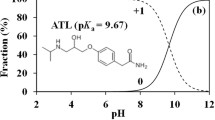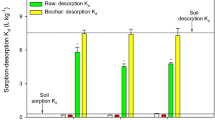Abstract
Background and aims
Plant uptake of active pharmaceutical ingredients (APIs) is increasingly leading to concerns about their potential exposure to humans and wildlife via dietary intake. Due to the extraordinary ability of biochars to bind organic compounds, plant uptake experiments were conducted to assess the effect of soil-amendment of three different biochars on the uptake of APIs from spiked soil.
Methods
Pot experiments were undertaken to assess the extent of sorption and corresponding bioaccessibility of two APIs (carbamazepine - CBZ and propranolol -PRL) to ryegrass (Lolium perenne) grown in an API-spiked loamy sand, with and without biochar amendment (5 t/ha equivalent). The soil was amended with three different biochars produced from eucalyptus wood and wheat residues.
Results
Both APIs were taken up by ryegrass, with CBZ preferentially accumulated (14.3 mg/kg CBZ, 3.8 mg/kg PRL in unamended soil) due to its comparatively high concentration in porewater. Soil amendment with biochars increased partitioning of the two APIs by up to three- fold, with corresponding decreases in porewater (34–72 % of unamended soil) and plant tissue (17–64 %) concentrations.
Conclusions
Biochars were effective in reducing the uptake of APIs into plant tissues from a contaminated soil and may be effective in the management of API residues in contaminated soils.


Similar content being viewed by others
References
Badalyan A, Pendleton P, Wu H (2001) Development of an automated gas adsorption apparatus for the characterization of the surface area, pore size distribution, and density of powdered materials. Rev Sci Instrum 72:3038–3045
Biederman LA, Harpole WS (2013) Biochar and its effects on plant productivity and nutrient cycling: a meta-analysis. Glob Chang Biol Bioenergy 5:202–214
Boxall ABA, Johnson P, Smith EJ, Sinclair CJ, Stutt E, Levy LS (2006) Uptake of veterinary medicines from soils into plants. J Agric Food Chem 54:2288–2297
Briggs GG, Bromilow RH, Evans AA (1982) Relationships between lipophilicity and root uptake and translocation of non-ionised chemicals by barley. Pest Sci 14:495–504
Briggs GG, Rigitano RLO, Bromilow RH (1987) Physicochemical factors affecting uptake by roots and translocation to shoots of weak acids in barley. Pest Sci 19:101–112
Burken J, Schnoor J (1998) Predictive relationship for uptake of organic contaminants by hybrid poplar trees. Environ Sci Technol 32:3379–3385
Cabrera A, Cox L, Spokas K, Hermosin MC, Cornejo J, Koskinen WC (2014) Influence of biochar amendments on the sorption–desorption of aminocyclopyrachlor, bentazone and pyraclostrobin pesticides to an agricultural soil. Sci Total Environ 470:438–443
Carter LJ, Harris E, Williams M, Ryan JJ, Kookana RS, Boxall ABA (2014) Fate and uptake of pharmaceuticals in soil-plant systems. J Agric Food Chem 62:816–825
Chefetz B, Mualem T, Ben-Ari J (2008) Sorption and mobility of pharmaceuticals compounds in soil irrigated with reclaimed water. Chemosphere 73:1335–1343
Chen BL, Zhou DD, Zhu LZ (2008) Transitional adsorption and partition of nonpolar and polar aromatic contaminants by biochars of pine needles with different pyrolytic temperatures. Environ Sci Technol 42:5137–5143
Chen ZM, Chen BL, Chiou CT (2012) Fast and slow rates of naphthalene sorption to biochars produced at different temperatures. Environ Sci Technol 46:11104–11111
Cunningham VL (2004) Special characteristics of pharmaceuticals related to environmental fate. In: Kummerer K (ed) Pharmaceuticals in the environment, 2nd edn. Springer, Berlin
Dechene A, Rosendahl I, Laabs V, Amelung W (2014) Sorption of polar herbicides and herbicide metabolites by biochar-amended soil. Chemosphere 109:180–186
Drillia P, Stamatelatou K, Lyberatos G (2005) Fate and mobility of pharmaceuticals in solid matrices. Chemosphere 60:1034–1044
Goldstein M, Shenker M, Chefetz B (2014) Insights into the uptake processes of wastewater-borne pharmaceuticals by vegetables. Environ Sci Technol 48:5593–5600
Graber E, Kookana RS (2014) Biochar and retention/efficacy of pesticides. In: Lehmann J, Joseph S (eds) Biochar for environmental management: science, technology and implementation/application. Earthscan, London
Graber ER, Tsechansky L, Gerstl Z, Lew B (2012) High surface area biochar negatively impacts herbicide efficacy. Plant and Soil 353:95–106
Hughes SR, Kay P, Brown LE (2013) Global synthesis and critical evaluation of pharmaceutical data sets collected from river systems. Environ Sci Technol 47:661–677
Jeong CY, Wang JJ, Dodla SK, Eberhardt TL, Groom L (2012) Effect of biochar amendment on tylosin adsorption-desorption and transport in two different soils. J Environ Qual 41:1185–1192
Jung C, Park J, Lim KH, Park S, Heo J, Her N, Oh J, Yun S, Yoon Y (2013) Adsorption of selected endocrine disrupting compounds and pharmaceuticals on activated biochars. J Hazard Mater 263:702–710
Kinney CA, Furlong ET, Werner SL, Cahill JD (2006) Presence and distribution of wastewater-derived pharmaceuticals in soils irrigated with reclaimed water. Environ Toxicol Chem 25:317–326
Kookana RS (2010) The role of biochar in modifying the environmental fate, bioavailability, and efficacy of pesticides in soils: a review. Aust J Soil Res 48:627–637
Kookana RS, Sarmah A, Van Zwieten L, Krull E, Singh B (2011) Biochar application to soil: agronomic and environmental benefits and unintended consequences. Adv Agron 112:103–143
Kookana RS, Williams M, Boxall ABA, Larsson DGJ, Gaw S, Choi K, Yamamoto H, Thatikonda S, Zhu YG, Carriquiriborde P (2014) Potential ecological footprints of active pharmaceutical ingredients: an examination of risk factors in low-, middle- and high-income countries. Philos Trans R Soc B Biol Sci 369:16
Lehmann J (2007) Bio-energy in the black. Front Ecol Environ 5:381–387
Malchi T, Maor Y, Tadmor G, Shenker M, Chefetz B (2014) Irrigation of root vegetables with treated wastewater: evaluating uptake of pharmaceuticals and the associated human health risks. Environ Sci Technol 48:9325–9333
Martin SM, Kookana RS, Van Zwieten L, Krull E (2012) Marked changes in herbicide sorption–desorption upon ageing of biochars in soil. J Hazard Mater 231:70–78
OECD (2000) Adsorption-desorption using a batch equilibrium method technical guideline 106 OECD-Organisation for Economic Cooperation and Development Paris 2000
Pignatello JJ, Xing BS (1996) Mechanisms of slow sorption of organic chemicals to natural particles. Environ Sci Technol 30:1–11
Rajapaksha AU, Vithanage M, Lim JE, Ahmed MBM, Zhang M, Lee SS, Ok YS (2014) Invasive plant-derived biochar inhibits sulfamethazine uptake by lettuce in soil. Chemosphere 111:500–504
Reid BJ, Pickering FL, Freddo A, Whelan MJ, Coulon F (2013) Influence of biochar on isoproturon partitioning and bioaccessibility in soil. Environ Pollut 181:44–50
Rittenhouse JL, Rice PJ, Spokas KA, Koskinen WC (2014) Assessing biochar’s ability to reduce bioavailability of aminocyclopyrachlor in soils. Environ Pollut 189:92–97
Sabourin L, Duenk P, Bonte-Gelok S, Payne M, Lapen DR, Topp E (2012) Uptake of pharmaceuticals, hormones and parabens into vegetables grown in soil fertilized with municipal biosolids. Sci Total Environ 431:233–236
Saito T, Otani T, Seike N, Murano H, Okazaki M (2011) Suppressive effect of soil application of carbonaceous adsorbents on dieldrin uptake by cucumber fruits. Soil Sci Plant Nutr 57:157–166
Sato T, Qadir M, Yamamoto S, Endo T, Zahoor A (2013) Global regional and country level need for data on wastewater generation treatment and use. Agric Water Manag 130:1–13
Shenker M, Harush D, Ben-Ari J, Chefetz B (2011) Uptake of carbamazepine by cucumber plants—a case study related to irrigation with reclaimed wastewater. Chemosphere 82:905–910
Sicbaldi F, Sacchi GAG, Trevisan M, Del AAM (1997) Root uptake and xylem translocation of pesticides from different chemical classes. Pest Sci 50:111–119
Sopena F, Bending GD (2013) Impacts of biochar on bioavailability of the fungicide azoxystrobin: a comparison of the effect on biodegradation rate and toxicity to the fungal community. Chemosphere 91:1525–1533
Sopena F, Semple K, Sohi S, Bending G (2012) Assessing the chemical and biological accessibility of the herbicide isoproturon in soil amended with biochar. Chemosphere 88:77–83
SRC (2014) FatePointer. Interactive PhysProp Database, Syracuse Research Corporation. URL: http://esc.syrres.com/fatepointer/search.asp (last accessed 15/12/2014)
Tatarkova V, Hiller E, Vaculik M (2013) Impact of wheat straw biochar addition to soil on the sorption, leaching, dissipation of the herbicide (4-chloro-2-methylphenoxy)acetic acid and the growth of sunflower (Helianthus annuus L.). Ecotox Environ Safe 92:215–221
Trapp S (2000) Modelling uptake into roots and subsequent translocation of neutral and ionisable organic compounds. Pest Manag Sci 56:767–778
USEPA (2004) Revised assessment of detection and quantitation approaches EPA-821-B-04-005. Engineering and Analysis Division, Office of Science and Technology, U.S. Environmental Protection Agency, Washington, DC
Vithange M, Rajapaksha AU, Tang X, Thiele-Bruhn S, Kim KY, Lee SE, Oak YS (2014) Sorption and transport of sulfamethazine in agricultural soils amended with invasive-plant-derived biochar. J Environ Manage 141:95–103
Williams M, Ong PL, Williams DB, Kookana RS (2009) Estimating the sorption of pharmaceuticals based on their pharmacological distribution. Environ Toxicol Chem 28:2572–2579
Wu C, Spongberg AL, Witter JD, Min F, Czajkowski KP (2010) Uptake of pharmaceutical and personal care products by soybean plants from soils applied with biosolids and irrigated with contaminated water. Environ Sci Technol 44:6157–6161
Yamamoto H, Nakamura Y, Moriguchi S, Nakamura Y, Honda Y, Tamura I, Hirata Y, Hayashi A, Sekizawa J (2009) Persistence and partitioning of eight selected pharmaceuticals in the aquatic environment: laboratory photolysis, biodegradation, and sorption experiments. Water Res 43:351–362
Yang YN, Sheng GY, Huang M (2006) Bioavailability of diuron in soil containing wheat- straw-derived char. Sci Total Environ 354:170–178
Yang XB, Ying GG, Peng PA, Wang L, Zhao JL, Zhang LJ, Yuan P, He HP (2010) Influence of biochars on plant uptake and dissipation of two pesticides in an agricultural soil. J Agric Food Chem 58:7915–7921
Yao Y, Gao B, Chen H, Jiang LJ, Inyang M, Zimmerman AR, Cao XD, Yang LY, Xue YW, Li H (2012) Adsorption of sulfamethoxazole on biochar and its impact on reclaimed water irrigation. J Hazard Mater 209:408–413
Yu XY, Ying GG, Kookana RS (2006) Sorption and desorption behaviors of diuron in soils amended with charcoal. J Agric Food Chem 54:8545–8550
Yu XY, Ying GG, Kookana RS (2009) Reduced plant uptake of pesticides with biochar additions to soil. Chemosphere 76:665–671
Yu XY, Mu CL, Gu C, Liu C, Liu XJ (2011) Impact of woodchip biochar amendment on the sorption and dissipation of pesticide acetamiprid in agricultural soils. Chemosphere 85:1284–1289
Zheng H, Wang Z, Zhao J, Herbert S, Xing B (2013) Sorption of antibiotic sulfamethoxazole varies with biochars produced at different temperatures. Environ Pollut 181:60–67
Acknowledgments
The authors are thankful to Dr Lynne MacDonald (CSIRO) for the supply and properties of biochars; Dr Jun Du (CSIRO) for help in residue analyses of APIs, Dr Hong Yin (CSIRO) and Dr Philip Pendleton (University of South Australia) for surface area analysis and interpretation of results and Drs Laura Carter and Peter Bain (CSIRO) for comments on the manuscript. The authors would also like to thank the four anonymous reviewers who considerably improved the quality of this manuscript.
Author information
Authors and Affiliations
Corresponding author
Additional information
Responsible Editor: Johannes Lehmann.
Electronic supplementary material
Below is the link to the electronic supplementary material.
ESM 1
(DOCX 128 kb)
Rights and permissions
About this article
Cite this article
Williams, M., Martin, S. & Kookana, R.S. Sorption and plant uptake of pharmaceuticals from an artificially contaminated soil amended with biochars. Plant Soil 395, 75–86 (2015). https://doi.org/10.1007/s11104-015-2421-9
Received:
Accepted:
Published:
Issue Date:
DOI: https://doi.org/10.1007/s11104-015-2421-9




